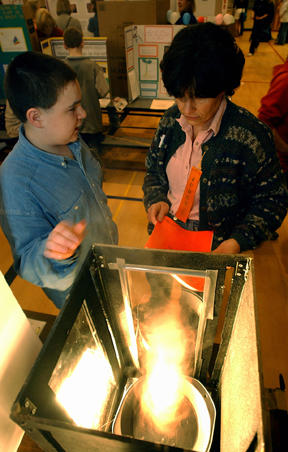Using a hot plate, a pan of water, a wooden box and a garage light, Jesse Rees not only built a working tornado, he also measured how the amount of available air affected the whirling vortex.
But for the young scientist, the coolest part of his experiment might have been the addition of a fifth component: a live mosquito.
“You know what happens when something gets sucked up into a twister? That’s pretty much what it did,” he said.
Rees was one of more than 200 sixth-grade students who participated in Thursday’s Science Fair at Sakai Intermediate School.
Displays filled the gymnasium, as a contingent of 70 parent judges examined projects and quizzed students on their work.
The range of inquiry exhibited by the young minds inspired equal parts bemusement and awe.
“How might the amount of dissolved salt affect the speed at which a marble rolls down a ramp underwater, as measured in milliliters and seconds?” one student sought to determine. (His conclusion: As the density of the solution increases, the marble slows.)
Others tested such phenomena as the effect of different fertilizers or colors of light on plant growth, and whether cotton or a polyester blend is more stain resistant.
One student tested the effect of different types music on the heart rate of the family tabby; another devised a way to test the relative strength of live crabs.
“The come from all angles, and it’s quite remarkable what they come up with,” said Doug Olson, longtime island science teacher.
But the project involved more than just putting together a display. Students also had to demonstrate understanding of the scientific method – observing a phenomenon, attempting to explain it with a hypothesis, postulating other results, and testing the theory by collecting data – that is the blueprint for formal inquiry.
Even when results were inconclusive, good tales followed.
Her curiosity piqued by a cookbook reference, one student sought to determine whether fresh eggs are easier to peel than those that have been sitting in the refrigerator.
The inquiry saw her test – and ingest – three dozen eggs a week for three weeks.
“The project was cool,” she wrote in her display abstract. “All in all, I almost had to peel 90 eggs or something. I will never eat another egg again, not until Easter, anyway.”
The Science Fair has been a staple of the middle-grade curriculum in Bainbridge schools for nearly 20 years. Next year it will shift down a grade, Olson said, to coincide with the Washington Assessment of Student Learning science test given to fifth-graders.
Among the areas in which students must show proficiency on the standardized battery is the scientific method.
“It turns out what we’ve been doing is really aligned with what the state wants kids to learn,” Olson said, “which is really gratifying.”


